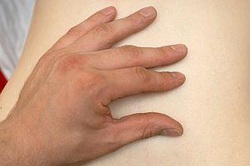 The Occupational Health and Safety Administration (OSHA) estimates that workplace-related injuries cost businesses nearly $170 billion each year. With money like this at stake, it’s easy to see that keeping your workers healthy through an Occupational Health and Safety (OHS) program could have a very high return on investment. And chiropractors can play a major role in helping companies to manage risk and improve productivity.
0 Comments
 The best treatment for illness is to give your body the tools to avoid becoming ill in the first place. Preventing a disease or condition is much easier and less costly than treating it once it has developed. And regular chiropractic care can be a very useful tool in your toolkit to help keep you healthy. Like health insurance, chiropractic care is there for you when you are suffering, but even better than health insurance, it can also help keep you from needing treatments that involve drugs (with their potential side effects) and invasive surgeries down the road.  Back pain affects a majority of people at some point in their lives. Why is that? There’s little doubt among researchers and clinicians that much of the back pain we experience is related to our modern lifestyle. However, recent research suggests that low back pain may also have a genetic component. While it’s too early to know for sure, this discovery might one day have implications for how healthcare providers identify at-risk individuals and help them through both prevention and treatment. Researchers from King’s College in London performed a study that was published in the journal Annals of Rheumatic Diseases that showed a specific gene was associated with a condition referred to as lumbar disc degeneration (LDD). LDD is one of the most common causes of low back pain, and it is usually related to the aging process, particularly among women. More than a third of all women aged 30 to 50 have at least one degenerated disc in their spine. It is estimated that as many as 80% of LDD cases are inherited.  Active Release Technique (ART) is making news! Articles in mainstream magazines like Men’s Journal and newspapers like the Wall Street Journal are introducing readers to this very effective—yet still little-known—hands-on therapy. So what exactly is ART? And what can it do for you? At the most basic level, ART uses a specific type of massage and movement to promote healing and reduce pain in muscles, tendons, ligaments and other connective tissue. Carpal tunnel syndrome, low back pain and runner’s knee are some of the more common conditions that respond well to ART. New York City chiropractor and ART therapist Keren Day told Men’s Journal, “Tight, dysfunctional muscles are tugging and pulling at the joint or irritating nerves, and often that's what is causing the injury.”  The healthy shoulder joint allows us to move our arms a full 270 degrees in range, which no other joint can do. When you consider the shoulder’s range of motion and its complexity, it’s no wonder that this joint is particularly prone to injury. However, there are some steps you can take to help prevent shoulder damage. The anatomy of the shoulder involves not only the ball-and-socket type glenohumeral joint that most people are familiar with (which allows for a wide range of movement), but three other joints as well, all supported by tendons and ligaments. These four joints are composed of the glenohumeral, scapulothoracic, acromioclavicular and sternoclavicular joints. The two clavicular joints are not very mobile, so injuries to these are often the cause of shoulder complaints. But because the glenohumeral and scapulothoracic joints have such a wide range of motion, the supporting tendons and ligaments are more prone to injury.  Carpal Tunnel Syndrome (CTS), named from the carpal bones in the wrist that form a tunnel around the nerve leading to the hand, is an injury usually caused by repetitive and forceful movements that result in swelling around the tendons and pinching of the median nerve, causing painful tingling, lack of muscle strength and control in the hand, and pain shooting from the hand up to the shoulder. CTS is a risk to most workers, such as those who work on the computer and also store and assembly line workers, who receive micro-traumas to their hands and wrists on a daily basis due to awkward positioning, forceful and repetitive movements, and stressful activity. The usual treatment for Carpal Tunnel Syndrome can extend to heavy medication and surgery, however there are alternative methods of treatment that can alleviate the symptoms and effects arising from CTS. Chiropractic treatment for CTS has been studied against conventional non-surgical medical treatment and was found to be effective. This offers an alternative to sufferers who are intolerant to ibuprofen, or those who simply wish to avoid treating with medication. The median nerve in the wrist, which when trapped causes Carpal Tunnel Syndrome, connects to the spinal cord through the openings in the bones in the areas around the lower neck. If these bones in the spinal cord lose their ordinary position or motion, this can cause problems in the wrists or fingers. Through chiropractic treatment, these bones can be reset to the correct position and can help to treat CTS. If Carpal Tunnel Syndrome is detected early, then surgery can be avoided, and chiropractic treatment is the leading method of non-surgical treatment. Chiropractic treatment usually involves various methods, with a combination of rest, ice, ultrasound, and electrical stimulation, including: · By chiropractic manipulation therapy of the elbow and upper spine, where the joint’s soft tissue undergoes manipulation; · Nutritional supplements in the diet such as B6, a vitamin that has had long-term promotion in its treatment of CTS; · Exercises for the wrist and hand designed to encourage recovery; · Reassessing the ergonomics of the work place to minimize stress the best way as possible. Recent studies concluded that using manual therapy intervention such as soft tissue mobilization (STM) has been found to help improve the signs and symptoms of CTS, with improvements to nerve conduction latencies, wrist strength and motion. Carpal Tunnel Syndrome can become a serious health problem, and if left too long may require surgery. If it’s caught early, then chiropractic treatment is an effective, drug-free method to ease the symptoms and pains caused by CTS, and provide long-term relief from CTS. Every body is different. If you have questions about this article or whether chiropractic is an appropriate choice for your specific situation, please ask. We are here to help!  Chiropractic for Chronic Back Pain About a third of the millions of people who make appointments with chiropractors every year seek relief from back pain. Back pain can be acute, meaning it happens suddenly, lasts 6 weeks or less and often clears up on its own; or back pain can be chronic, meaning it comes on gradually and lasts 3 months or more. Chronic back pain can be particularly debilitating and can limit movement and mobility. Traditional treatments for back pain include medication, physical therapy, surgery or steroid injections. While these treatments may provide symptomatic relief, they do not address the root cause of the pain. They can also be painful and expensive to carry out. The foundation of chiropractic care for chronic back pain is the understanding that misaligned vertebrae can cause the pain. This misalignment can result in many additional problems, such as headaches, body pains and impaired joint mobility. Chiropractic treatment aims to restore alignment to the vertebrae, returning natural health to the spine and all the body parts the spinal nerves serve. Chiropractors believe in the body’s natural ability to heal itself. Chiropractic care avoids medications and their possible side effects, and it also avoids surgery. As an example of the differences in treatment, surgeons may remove a herniated disk from the spine in order to relieve pressure on the nerves, while chiropractors use non-invasive spinal manipulation to achieve the same result. Your chiropractor will treat your chronic pain based on the vertebral misalignments found in your body. A quick, sudden force is applied to the appropriate vertebrae in order to restore the motion of the joint. Another common treatment for chronic pain is known as the flexion-distraction technique. This treatment involves a special table that stretches the spine. It is particularly effective in treating injuries to the discs that have been the cause of long-term back pain. Chronic back pain will probably also require additional treatments such as massage, exercise, and perhaps physical therapy. A good chiropractor will work with other health professionals as needed to ensure you get the best possible treatment for your pain. He or she will also look at the entire picture of your life, including your diet, health habits, medical history, family history, and other conditions you may have. This approach is holistic and has a better chance of eliminating the root cause of your chronic back pain than traditional treatments that only work on the symptoms. Every body is different. If you have questions about this article or whether chiropractic is an appropriate choice for your specific situation, please ask. We are here to help! |
AuthorPosted by Dr. Babak Missaghi Archives
August 2017
Categories
All
|

 RSS Feed
RSS Feed
